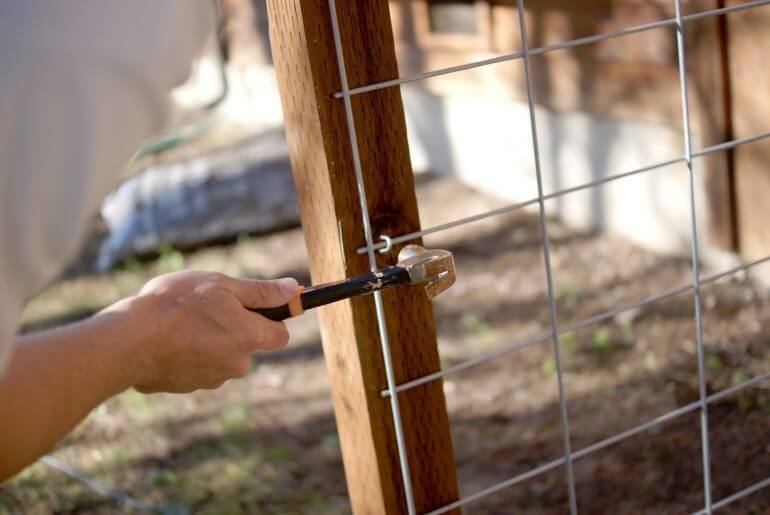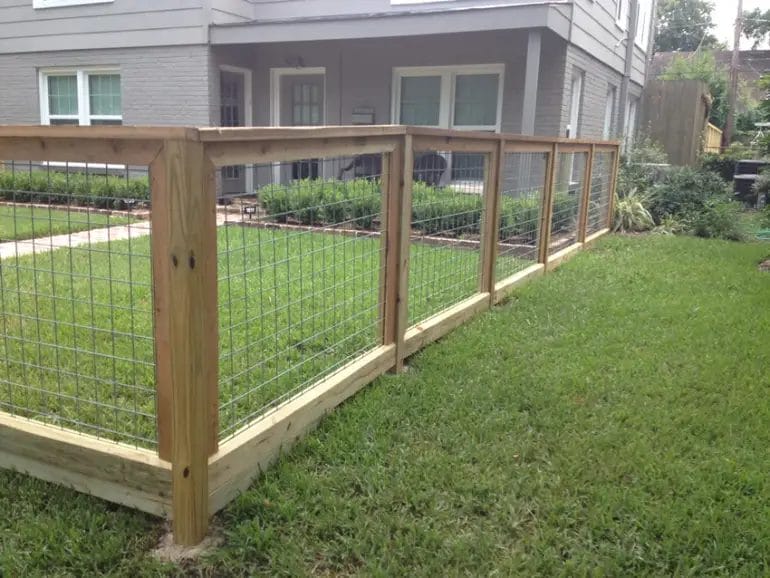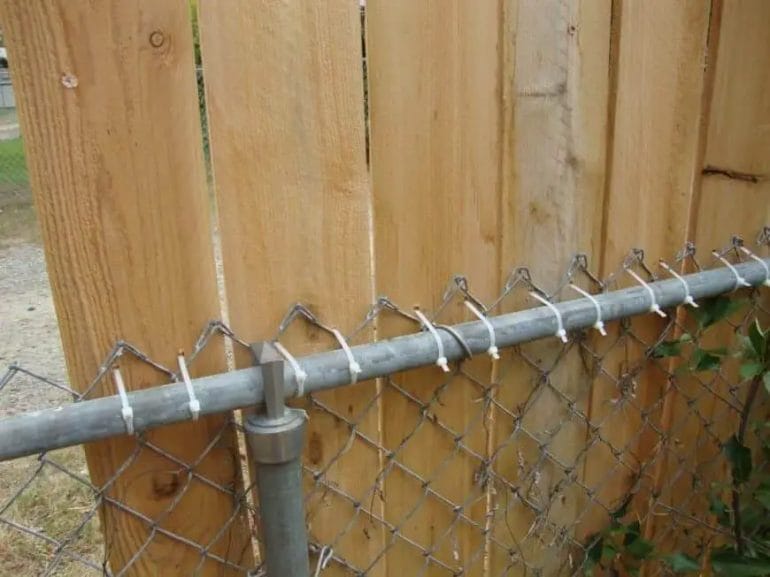Attaching a wire fence to a wood post is a straightforward task that requires some basic knowledge and tools. Whether you are securing your garden or creating a boundary for your property, the right technique is essential for a long-lasting fence installation.
In this guide, we will walk you through the step-by-step process of securely attaching a wire fence to a wood post. From choosing the appropriate materials to securing the fence tightly, we’ll cover all the essential details to ensure a strong and durable fence.

By following these instructions, you’ll be able to confidently attach a wire fence to a wood post, providing security and peace of mind for your property.

Step-by-Step Guide for Attaching Wire Fence to Wood Post
If you have a wire fence and want to attach it to a wood post, you’ve come to the right place. In this guide, we’ll walk you through the process step-by-step, ensuring that your fence is securely attached and ready to withstand the test of time.
Materials Needed:
- Wood posts
- Wire fence
- Fence staples or U-nails
- Wire cutters
- Hammer
- Tape measure
- Level
- Post hole digger
- Concrete mix (optional)
Step 1: Prepare Wood Posts
Start by determining the spacing between your wood posts. This will depend on the size of your wire fence and your personal preference. Use a tape measure to mark where each post will be placed. Make sure the posts are evenly spaced.
Next, dig holes for the wood posts using a post hole digger. The depth of the hole should be at least one-third the height of the wood post. If you want extra stability, you can add concrete mix to the hole and allow it to set before inserting the post.
Step 2: Attach Wire Fence to First Post
Take one end of the wire fence and secure it to the first wood post. Start at the bottom and work your way up. Use fence staples or U-nails to attach the wire to the post. Make sure the wire is stretched tightly to avoid sagging.
Use a level to ensure that the wire fence is straight before securing it to the post. This will prevent any unevenness in your fence line.
Step 3: Stretch Wire Fence to Second Post
Once the wire fence is securely attached to the first post, stretch it tightly to the next post. This can be done by pulling the wire and using a hammer to secure it to the second post using fence staples or U-nails.
Again, use a level to ensure that the wire fence is straight before securing it to the post.
Step 4: Repeat for Remaining Posts
Continue attaching the wire fence to the remaining wood posts, following the same process as before. Make sure to stretch the wire tightly and use a level to ensure straightness.
If your wire fence is taller than your wood posts, you may need to attach additional pieces of wire to extend the height. Simply overlap the wire and secure it to the posts using fence staples or U-nails.
Step 5: Trim Excess Wire
After all the wire has been attached to the wood posts, use wire cutters to trim any excess wire. This will give your fence a clean and finished appearance.
Be sure to wear gloves when cutting the wire to protect your hands.
Step 6: Inspect and Maintain
Once the wire fence is fully attached to the wood posts, take a moment to inspect the entire fence line. Make sure all the wire is tightly secured and there are no loose connections.
Regularly check the fence for any damage or wear, and make any necessary repairs to ensure the longevity of your fence.
Summary
Attaching a wire fence to wood posts is a straightforward process that can be accomplished with a few simple steps. By following this step-by-step guide, you can ensure that your fence is securely attached and ready to provide the desired functionality and aesthetic appeal.
Remember to measure and mark the post spacing, dig appropriate holes, and use a level to keep the fence straight. Stretch the wire tightly and secure it with fence staples or U-nails. Trim any excess wire and regularly inspect and maintain your fence to keep it in optimal condition.

Types of Hardware for Attaching Wire Fence to Wood Post
When it comes to installing a wire fence on a wood post, choosing the right hardware is essential. The hardware you use will determine the stability and durability of your fence. There are several types of hardware available that are specifically designed to attach wire fencing to wood posts. In this section, we will explore some of the most common types of hardware used for this purpose.
1. Fence Staples
Fence staples are a popular choice for attaching wire fence to wood posts. These staples are U-shaped and can be easily hammered into the wood, securing the fence tightly. They are made of galvanized steel or stainless steel, which makes them resistant to rust and corrosion. Fence staples come in various sizes, so you can choose the one that suits the gauge of your wire fence.
2. U-Nails
U-nails, also known as U-shaped nails or horseshoe nails, are another type of hardware commonly used for attaching wire fence to wood posts. These nails have a U shape with sharp ends that can be easily driven into the wood, holding the fence securely. U-nails are available in different sizes and materials, including galvanized steel and stainless steel.
3. Wire Clips
Wire clips are metal clips specifically designed for attaching wire fence to wood posts. These clips have a loop shape that allows the wire to pass through, holding it firmly in place. Wire clips are typically made of galvanized steel or aluminum, which provides excellent durability and resistance to weathering. They are easy to install and can be tightened with pliers for added security.
4. Tension Bands
Tension bands are commonly used in conjunction with wire fence and wood posts to create a secure and stable fencing system. These bands are placed around the post and are used to hold the wire fence in place by connecting it to tension bars or rails. Tension bands are made of galvanized steel and are available in various sizes to accommodate different fence gauges.
5. Fence Brackets
Fence brackets are metal brackets that are used to attach wire fence to wood posts. These brackets have a flat or L-shaped design and are installed by screwing or nailing them onto the wood post. The wire fence can then be attached to the brackets using wire clips or other types of fasteners. Fence brackets are available in different sizes and materials, including galvanized steel and aluminum.
6. Fence Post Caps
Although not directly used for attaching wire fence to wood posts, fence post caps play an important role in protecting the top of the post from moisture and weathering. These caps are typically made of plastic or metal and can be easily installed on top of the wood post. Apart from providing protection, fence post caps also add a decorative element to your fence.
Choosing the right hardware is crucial for attaching wire fence to wood posts. Whether you opt for fence staples, U-nails, wire clips, tension bands, fence brackets, or a combination of these, make sure to select hardware that is compatible with your fence gauge and offers durability and weather resistance. By using the appropriate hardware, you can ensure the stability and longevity of your wire fence installation.

Common Mistakes to Avoid When Attaching Wire Fence to Wood Post
Attaching a wire fence to a wood post is a common method used to secure and enclose an area. Whether you are installing a fence for the first time or making repairs, it is important to know the common mistakes that should be avoided. These mistakes can compromise the strength and durability of the fence, leading to potential safety hazards and costly repairs down the line. In this section, we will discuss some of the most common mistakes to avoid when attaching a wire fence to a wood post.
1. Incorrect Post Spacing
One of the most crucial aspects of attaching a wire fence to a wood post is ensuring proper post spacing. Each post should be evenly spaced to provide sufficient support and prevent sagging or leaning. It is recommended to space the wood posts no more than 8 feet apart for optimal strength and stability. Failing to maintain the correct post spacing can result in a weak fence that may not withstand environmental factors such as wind or pressure.
2. Insufficient Depth of Post Holes
Another common mistake is not digging the post holes deep enough. The depth of the post holes is essential for ensuring the stability of the fence. As a general rule, the post holes should be at least one-third the total length of the wood post. For example, if you are using 8-foot-long posts, the holes should be at least 2.5-3 feet deep. Inadequate depth can lead to unstable posts that may wobble or shift over time.
3. Improper Post Anchoring
Proper post anchoring is vital for securing the fence to the wood posts. One common mistake is relying solely on nails or screws to attach the wire fence to the posts. This can result in a weak connection that may become loose or detached with time. It is recommended to use sturdy metal brackets or specialized post anchors to ensure a secure attachment. These provide increased stability and prevent the fence from pulling away or collapsing.
4. Failure to Tension the Wire Properly
Tensioning the wire is a critical step in ensuring a taut and secure fence. Failure to properly tension the wire can lead to sagging or loose sections, compromising the integrity of the fence. To achieve proper tension, use tensioning devices such as turnbuckles or wire strainers at the corners and ends of the fence. These devices allow for easy adjustment and ensure the wire remains tight and in place.
5. Lack of Proper Wire Protection
Without adequate protection, the wire used in the fence can be susceptible to damage from weather conditions, UV exposure, or external forces. It is essential to protect the wire by using appropriate measures such as applying a protective coating or opting for galvanized or vinyl-coated wire. These protective layers help to prolong the lifespan of the fence and reduce the risk of rusting, corrosion, or deterioration.
6. Neglecting Regular Maintenance
Once the wire fence is installed, it is important to practice regular maintenance to ensure its longevity and effectiveness. Neglecting maintenance can lead to issues such as rust, loose wires, or damaged posts, which can compromise the overall integrity of the fence. Regularly inspect the fence, tighten any loose wires or connections, and address any signs of damage promptly to prevent further deterioration.
In summary, attaching a wire fence to a wood post requires careful attention to detail and proper installation techniques. By avoiding these common mistakes, you can ensure a sturdy and durable fence that will provide both security and aesthetics to your property. Remember to maintain the fence regularly and address any issues promptly to extend its lifespan and avoid costly repairs in the future.
Tips for Ensuring a Secure Attachment of Wire Fence to Wood Post
Installing a wire fence can be a great way to secure your property and provide a boundary for your pets or livestock. However, it is important to ensure that the wire fence is securely attached to the wood posts to prevent any sagging or shifting over time. In this section, we will discuss some tips to help you achieve a secure attachment of a wire fence to a wood post.
1. Choose the Right Materials
Before you start installing your wire fence, make sure you have the right materials on hand. For attaching the wire fence to the wood post, you will need sturdy fence staples or galvanized nails. These materials are designed to withstand outdoor conditions and provide a secure attachment.
2. Properly Space Your Wood Posts
One key factor in ensuring a secure attachment of the wire fence is the spacing of your wood posts. The distance between each post will depend on the type of wire fence you are installing and the terrain of your property. As a general rule, wood posts should be spaced approximately 8 to 10 feet apart.
3. Use Tension Wire
To prevent the wire fence from sagging, it is recommended to use tension wire along the top and bottom of the fence. Tension wire is a strong wire that runs parallel to the fence, providing extra support and preventing any slack. Attach the tension wire to the wood posts using fence staples or nails, ensuring it is pulled tight and securely fastened.
4. Attach the Wire Fence to the Wood Posts
When attaching the wire fence to the wood posts, start at one end and work your way along the fence line. Use fence staples or galvanized nails to secure the wire to the wood posts. Ensure that the staples or nails are driven in at a slight angle to provide a stronger hold. Attach the wire at regular intervals, approximately every 8 to 12 inches.
5. Check for Stability
Once you have attached the wire fence to the wood posts, check for stability. Gently push or pull the fence to check for any signs of sagging or shifting. If you notice any instability, reinforce the attachment points by adding additional staples or nails. It is important to address any issues early on to prevent further problems down the line.
6. Regular Maintenance
To ensure a long-lasting and secure attachment of your wire fence to the wood posts, it is important to perform regular maintenance. Inspect the fence regularly for any signs of damage or loose attachments. Replace any damaged wire or tighten any loose staples or nails as needed.
7. Consider Professional Installation
If you are unsure about installing the wire fence yourself or if you have a large or complex area to fence, it may be worth considering professional installation. A professional installer will have the experience and knowledge to ensure a secure attachment of the wire fence to the wood posts, providing you with peace of mind and a professionally installed fence.
Summary
Ensuring a secure attachment of a wire fence to a wood post is vital for the longevity and effectiveness of the fence. By following these tips and using the right materials, you can achieve a strong and stable wire fence installation. Remember to space your wood posts correctly, use tension wire for added support, and regularly inspect and maintain your wire fence to keep it in optimal condition.
FAQs
1. How do I attach a wire fence to a wood post?
To attach a wire fence to a wood post, you can use either galvanized fence staples, U-nails, or screws. Start by positioning the wire against the post and secure it using the chosen fasteners. Make sure to space the fasteners evenly along the post to ensure a secure attachment.
2. What type of fasteners should I use to attach a wire fence to a wood post?
The most common options for fastening a wire fence to a wood post are galvanized fence staples, U-nails, or screws. Choose the type of fastener based on your personal preference and the specific requirements of your fence. Make sure to use high-quality, corrosion-resistant fasteners for long-lasting durability.
3. Are there any tips for ensuring a secure attachment of a wire fence to a wood post?
Yes, here are a few tips: 1) Pre-drill holes in the wood post to prevent splitting when using screws. 2) Use a fence clip or wire tensioner to maintain tension in the wire. 3) Consider using additional supports such as tension bands or wire ties for added stability. 4) Regularly inspect and tighten the fasteners to ensure the fence remains securely attached.
Conclusion
In conclusion, attaching a wire fence to a wood post can be a simple and effective way to secure your property or create boundaries. By following the proper steps and using the right materials, you can ensure a secure and durable fence that will last for years to come. Remember to choose the appropriate size and type of wire for your needs and use sturdy fasteners such as staples or screws to secure the wire to the wood post. Regular maintenance and inspections will also help to keep your fence in good condition and ensure its longevity.
Whether you’re installing a fence for privacy, security, or to keep pets in, attaching a wire fence to a wood post is a straightforward process. Begin by prepping the post, ensuring it is deep enough and properly secured in the ground. Then, attach the wire to the post using galvanized staples or screws, making sure to stretch it taut and securely fasten it. Lastly, regularly inspect and maintain the fence to ensure its effectiveness. By following these guidelines, you can successfully attach a wire fence to a wood post and enjoy the benefits it provides.